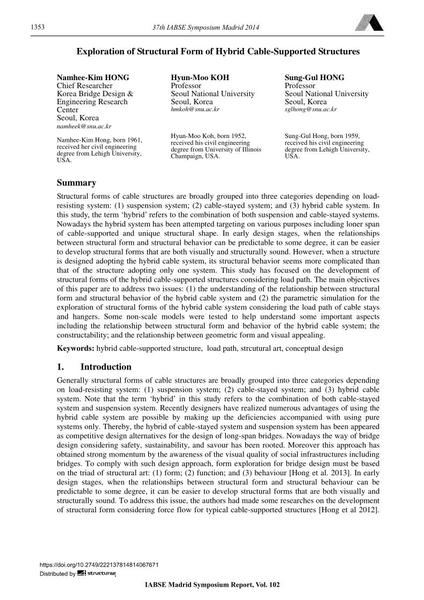Exploration of Structural Form of Hybrid Cable-Supported Structures

|
|
|||||||||||
Bibliographic Details
| Author(s): |
Namhee-Kim Hong
Hyun-Moo Koh Sung-Gul Hong |
||||
|---|---|---|---|---|---|
| Medium: | conference paper | ||||
| Language(s): | English | ||||
| Conference: | IABSE Symposium: Engineering for Progress, Nature and People, Madrid, Spain, 3-5 September 2014 | ||||
| Published in: | IABSE Symposium Madrid 2014 | ||||
|
|||||
| Page(s): | 1353-1360 | ||||
| Total no. of pages: | 8 | ||||
| Year: | 2014 | ||||
| DOI: | 10.2749/222137814814067671 | ||||
| Abstract: |
Structural forms of cable structures are broadly grouped into three categories depending on load- resisting system: (1) suspension system; (2) cable-stayed system; and (3) hybrid cable system. In this study, the term ‘hybrid’ refers to the combination of both suspension and cable-stayed systems. Nowadays the hybrid system has been attempted targeting on various purposes including loner span of cable-supported and unique structural shape. In early design stages, when the relationships between structural form and structural behavior can be predictable to some degree, it can be easier to develop structural forms that are both visually and structurally sound. However, when a structure is designed adopting the hybrid cable system, its structural behavior seems more complicated than that of the structure adopting only one system. This study has focused on the development of structural forms of the hybrid cable-supported structures considering load path. The main objectives of this paper are to address two issues: (1) the understanding of the relationship between structural form and structural behavior of the hybrid cable system and (2) the parametric simulation for the exploration of structural forms of the hybrid cable system considering the load path of cable stays and hangers. Some non-scale models were tested to help understand some important aspects including the relationship between structural form and behavior of the hybrid cable system; the constructability; and the relationship between geometric form and visual appealing. |
||||
| Keywords: |
conceptual design load path hybrid cable-supported structure strcutural art
|
||||

